The comparison between two so similar martial arts like Judo and Brazilian Jiu-Jitsu is inevitable. For a novice, they will probably look indistinguishable from each other.
Both martial arts involve practitioners wearing kimonos and wrestling in a standing position on a mat and eventually going on the ground. However, as you explore each art, you will find some major differences between the two.
Judo and BJJ are both grappling arts but Judo is focused on throwing techniques with little groundwork while BJJ focuses on groundwork with little throwing and takedown techniques.
But there are more differences between Judo and BJJ than just their styles so you may have more questions than answers. Which one is more popular? Should you opt for BJJ, Judo, or both?
What Is Judo
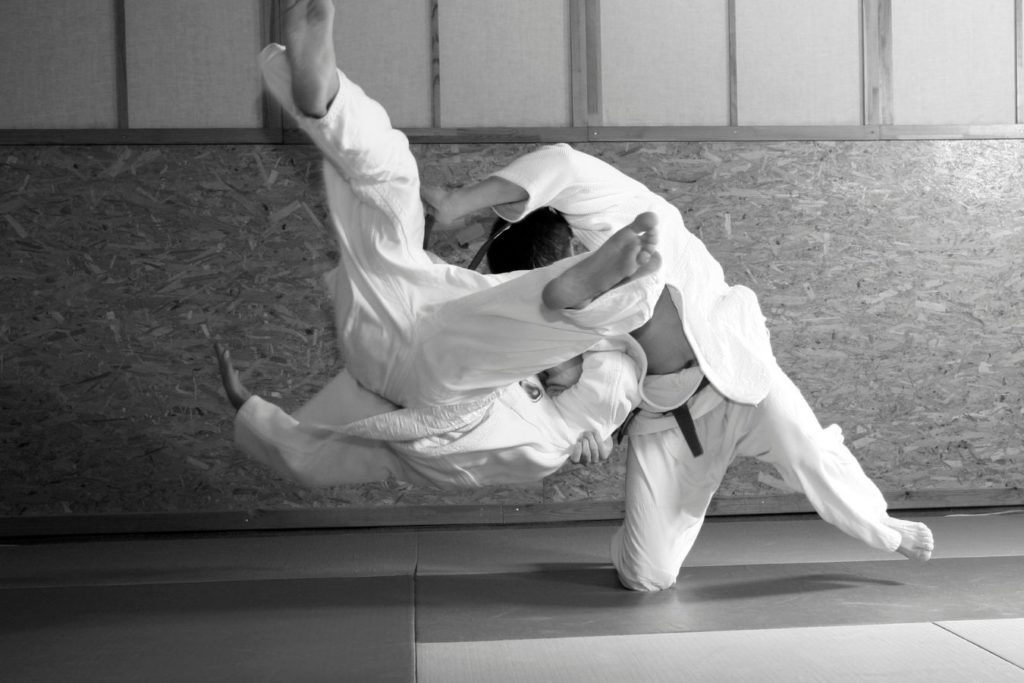
Judo is a Japanese grappling martial art and an Olympic sport with a heavy emphasis on throwing techniques and a much more limited ground grappling element.
Both Judo and BJJ can be traced back to traditional Japanese Jujitsu (also spelled jujutsu). It can be difficult to find out exactly when jujutsu came into being, but a text from early 720 AD mentions something regarding “contests of strength.”
Japan’s whole history as well as that of jujutsu is invariably connected with the famous caste of feudal-era warriors the Samurai. When roughly translated, Jujutsu means gentle art, and its initial focus was to teach the Samurai unarmed fighting skills.
Because they wore armor, jujutsu focused on grappling techniques like throwing, gouges, and locks, which worked against an armored opponent, unlike unarmed strikes. During the peaceful Edo period in Japan, the martial art also began focusing more on completely unarmed fighting.
In 1870, the Meiji Restoration ended the feudal system, and Samurai became extinct. People were no longer allowed to wear swords in public, and martial arts schools started to collapse.
That is when a young man named Jigoro Kano became captivated by this form of art and wanted to spread it. He knew he would have to tweak jujutsu for mass acceptance, especially for the latest political landscape.
5 Step Blueprint To Build A BJJ Strength Workout To Demolish Your Opposition
Learn how to plan your strength training to maximize transfer to the mats.
Jigoro Kano worked on developing his own brand of jujutsu after mastering some of the traditional styles and in 1882, he opened a new martial art school called “Kodokan”. By changing the name, he hoped to distinguish his teachings from the traditional Japanese way.
Kano opted for a scientific approach and strived for maximum efficiency in human movement, which gave birth to Judo.
Kano was very influential in spreading this new form of martial arts, and the navy and police also adopted Kano’s technique. In 1909, he was invited as the first Asian representative from Japan to the Olympic Committee. In 1964, Judo became an Olympic sport at the Tokyo Games.
What Is BJJ
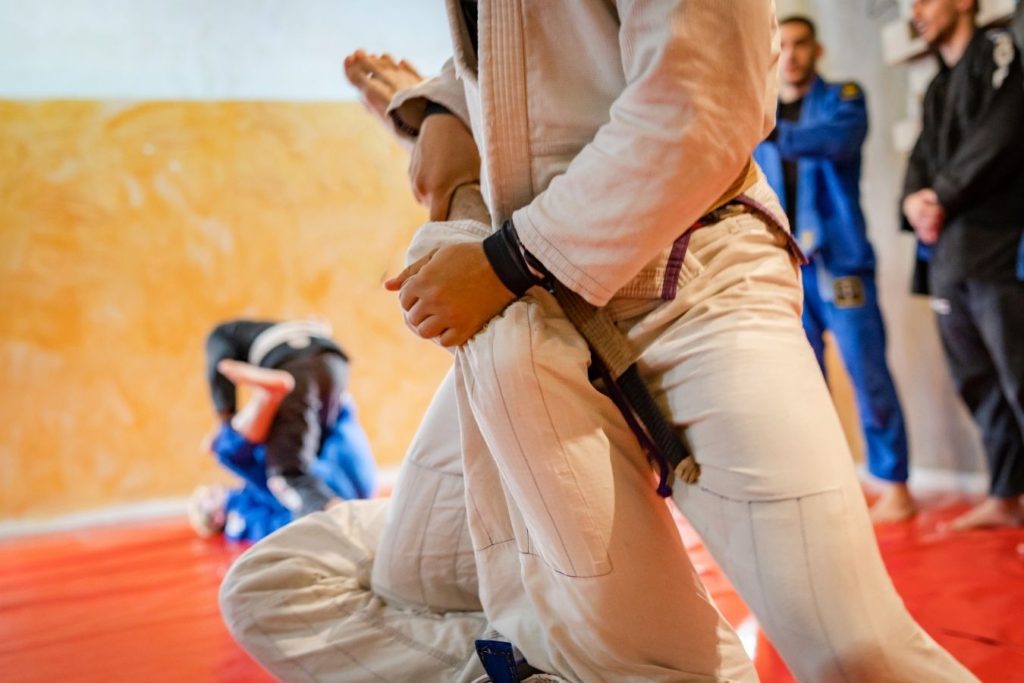
Brazilian Jiu-jitsu is a grappling combat sport focused first and foremost on ground fighting. Throws and takedowns do play a role, but the main goal of BJJ is to teach you how to submit an opponent on the ground, regardless of how you get there.
Even though Kano traveled the whole world, it was another judoka named Mitsuyo Maeda who brought Judo to Brazil. Mitsuyo was a disciple of Kano and left Japan for New York in 1905 to provide Judo demonstrations.
He traveled all over South and North America and arrived in Brazil in 1914. Maeda met with Gastao Gracie who introduced his son Carlos Gracie to martial arts. Soon enough, Carlos started to train along with his brothers, Jorge, Helio, and Oswaldo.
After a short while, the Gracies started to focus on the ground fighting portion of Judo known as the “Newaza” and became obsessed with “Vale-Tudo” fights. These fights pitted styles against one another in no-holds-barred matches.
Helio and Carlos Gracie are often credited as the inventors of Brazilian Jiu-Jitsu and they are the biggest figures, but the martial art has also had a lot of other influences mainly from Vale Tudo fighters and catch wrestlers at the time and there were other lineages involved in developing and spreading jiu-jitsu.
Even though BJJ started from Kodokan Judo, it has gradually morphed into a very different martial art and it’s time to explore the differences in detail.
What Is The Difference Between Judo And BJJ?
Techniques
Judo and BJJ share many similar techniques, such as joint locks, chokeholds, and throws. The main difference is which techniques are more emphasized than others.
Judo focuses more on the throwing techniques, whereas BJJ emphasizes submissions and groundwork, which makes a lot of difference in the dynamics of a match.
Judo’s strategy focuses on the throwing aspect and performing a successful throw can win you the match directly. There is a plethora of techniques used to achieve that separated into different categories like hand throwing techniques, hip throws, foot throws or sweeps, and sacrifice techniques.
Ground wrestling is a part of judo but it’s much less important. Once on the mat judokas use pinning techniques and submission holds which can be strangles, chokes, and joint locks targetting the elbow. Initially, a lot more moves were legal in judo, but in time the sports ruleset has limited the techniques a lot.
Meanwhile, the BJJ strategy is focused more on the ground. Since 90% of BJJ matches are on the ground or end up on the ground, your focus is mainly on submissions and ground positions.
The ground positions like side control, mount, and the many guards are crucial in BJJ while the amount of submissions available is nearly endless and int includes all kinds of joint locks, chokes, strangulations, and other painful holds.
Rules
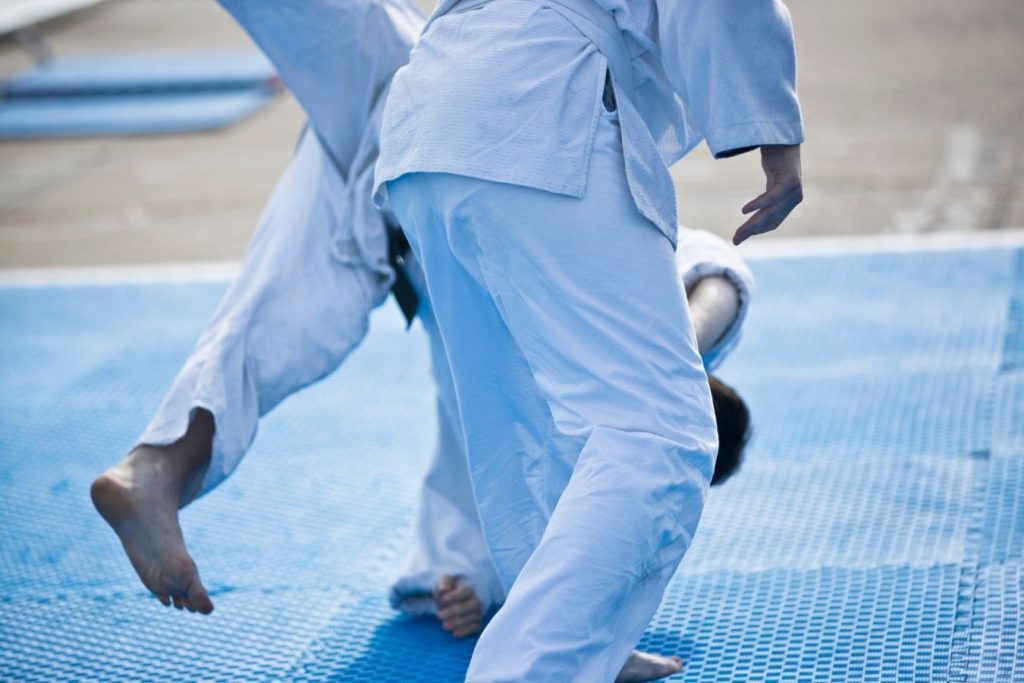
Judo Rules
In Judo, you can win the fight by “Ippon,” which can be achieved by:
- Throwing your rival with a considerable force so that they land on their back.
- Forcing your opponent to give up by tapping out
- Holding your opponent down for twenty seconds
Judokas can win points through another system called “Waza-ari.” This involves:
- Throwing your opponent to the mat but without enough force, speed, and control to be considered an ippon.
- Holding your opponent down for 10-19 seconds.
Rules have changed over time, but two Waza-ari allow you to win a match. Also, Judo grips are regulated; the type of grip and the location are very specific. For example, Judo does not allow you to grab the legs when standing, essentially removing double and single-leg takedowns.
BJJ Rules
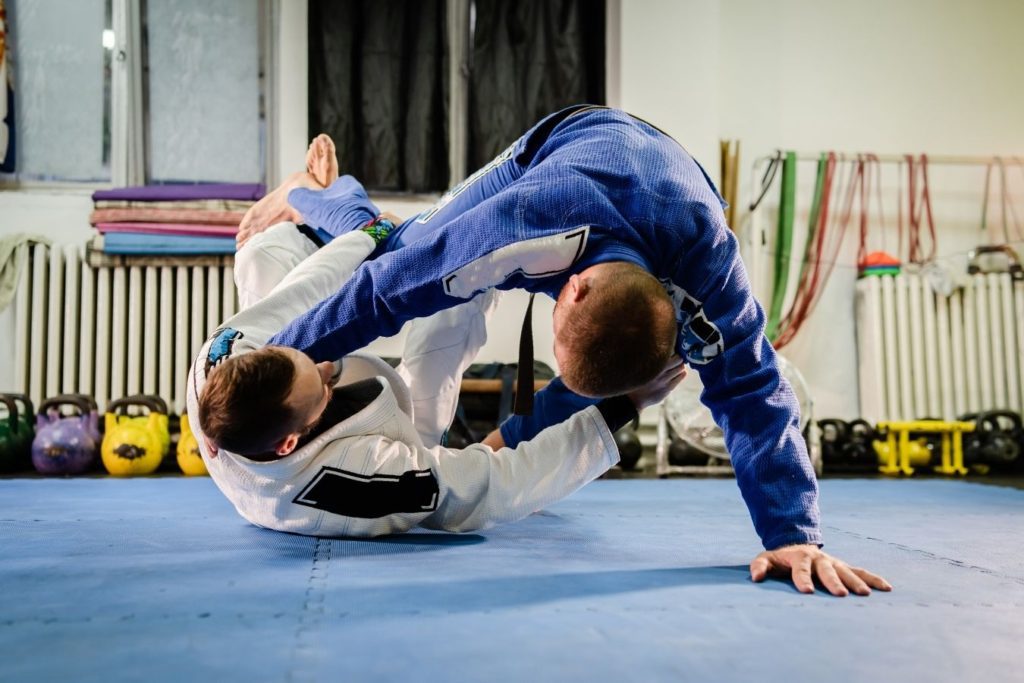
In BJJ matches, the goal of the match is to win by submitting the opponent or outscoring them. Points are scored for specific objectives like finishing a takedown or advancing into a more dominant position.
Here is what the scoring under the most popular IBJJF ruleset looks like:
- 2 points are given to you for a takedown
- 2 points are awarded to you for a sweep
- 3 points are provided to you for passing the opponent’s guard
- 4 points are given to you for back control
- 2 points are awarded when obtaining a knee-on-belly position
- 4 points are awarded for full mount control If no one taps, the fighter with the most points at the end of the match wins
BJJ allows a lot more submission techniques than Judo. This includes leg locks, chokes, varied armlocks, and more. Also, as long as competitors are trying to do something on the ground the referee will not stand them up, unlike in Judo.
Belt/Grading System
Judo belt progression varies from area to area. In most countries, there are six belts before the black belt. These belts are white, yellow, orange, green, blue, and brown and are awarded in this order.
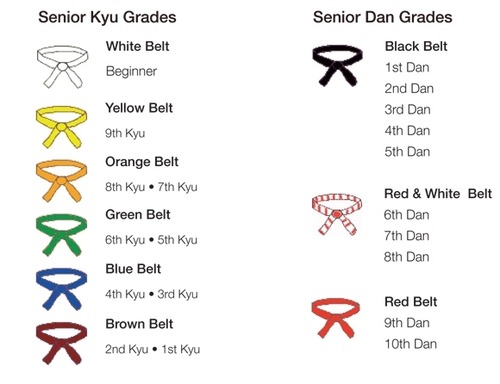
The BJJ belt progression system is similar, but it has fewer belts. In BJJ, the belts move from white to blue and then to purple, brown, and finally to black.
In both styles when you reach the black belt level you start earning ranks of the black belt called dans in Judo.

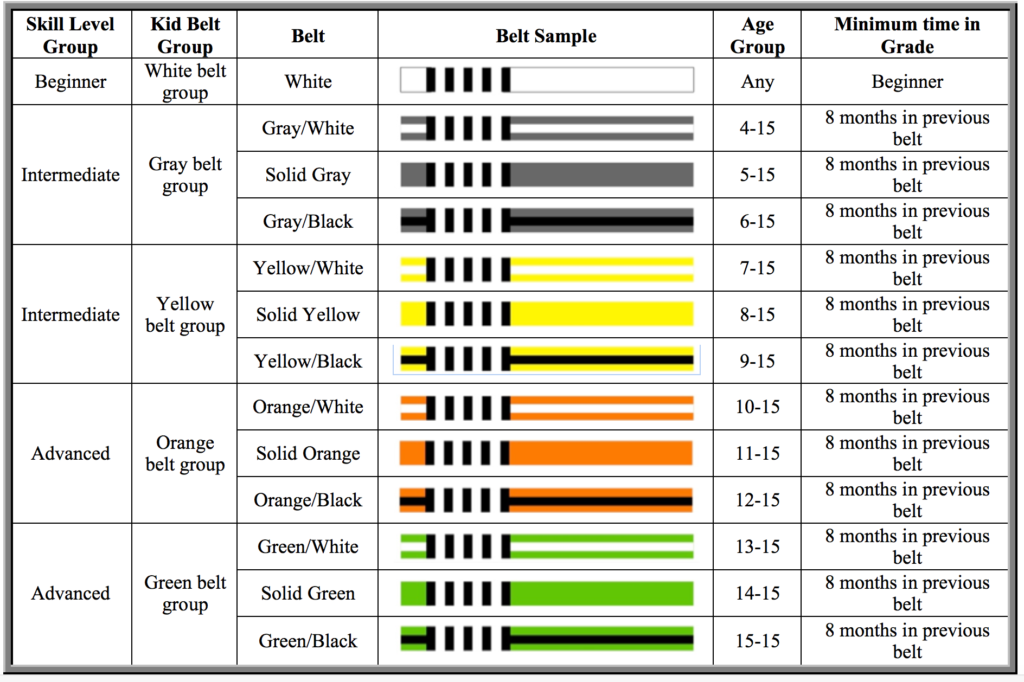
There is also a big difference in how the belts are earned. In judo to get promoted you have to attend an official test and pass certain requirements like performing specific techniques and physical exercises.
In BJJ there are no formal tests and the promotion is done based on the judgment of the instructor whenever he feels a practitioner is ready and worthy to be promoted to the next rank.
Equipment
Both traditional BJJ and Judo uniforms look very alike, but there are some minor differences. The kimono for Judo is heavier and more durable than a standard taekwondo or karate uniform since it is built to withstand throwing and gripping.
On the other hand, the BJJ gi is more durable and heavier than a Judo kimono because it must withstand more wear and tear from the constant contact with the mats and gripping while on the ground.
BJJ gis are also offered in more colors with the official competition allowed ones being white, black, and blue, whereas Judo only allows white and blue gis for competition.
BJJ also has no-gi competitions which have a closer similarity to wrestling but with submissions. The no-gi uniform is simply a rash guard or no top and BJJ shorts.
Competitive Landscape
Judo has been an Olympic sport for a long time which is a big reason for its immense popularity worldwide.
There is a judo competition circuit in the majority of countries around the world with domestic tournaments at all levels.
The next level of competitions is regional or continental tournaments, followed by world cups and finally the Olympic games.
Brazilian jiu-jitsu is also well developed as a sport, although not yet to the level of Judo. The IBJJF is the biggest organization and many national federations are part of it, so the majority of competitions are sanctioned by the IBJJF.
A big element missing from judo is the professional level of no-gi BJJ, although we can argue the sport is no longer BJJ but it’s more appropriately called submissions grappling.
Professional events like the ones held by EBI, Metamoris, WNO, and many others follow a structure similar to professional boxing and MMA events and are gaining more and more popularity.
Is Judo or BJJ Better For Self-Defense?
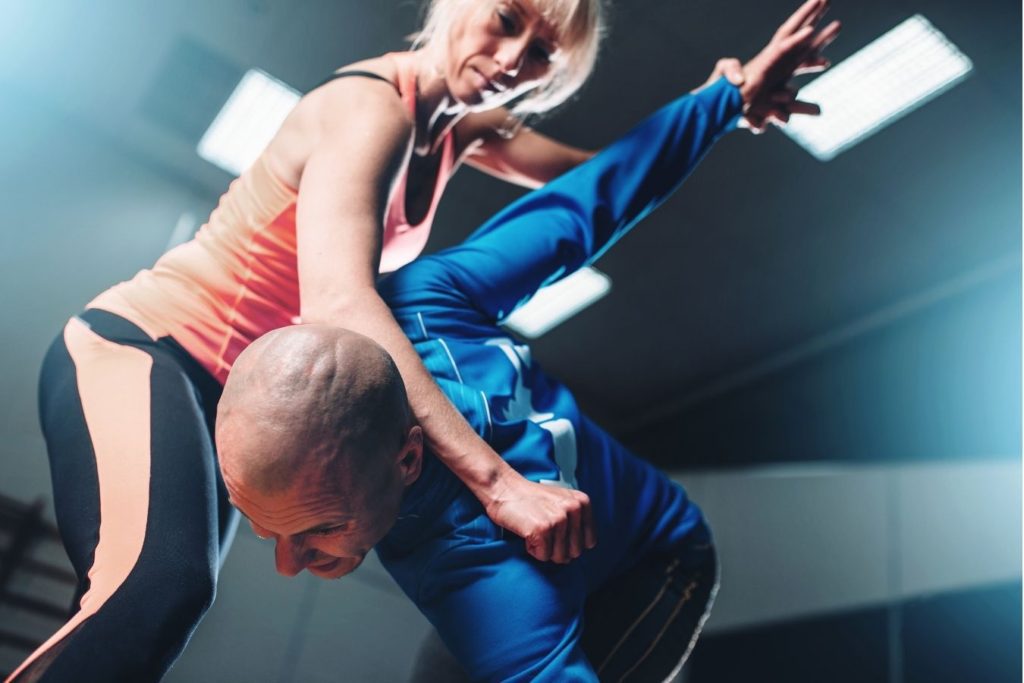
Both Judo and BJJ have their weaknesses and strengths but are great for self-defense. They are full-contact martial arts meaning training and competing will prepare you physically and mentally for actual conflict, at least in the domain the sports operate.
However, if you need one specifically for self-defense, then it would be BJJ. Judo has a lot of limitations imposed by the ruleset and this hurts the street fight effectiveness of the style, whereas BJJ has a lot more variety.
Judo training is done exclusively in the kimono making its transfer to street clothing less apt than a BJJ practitioner who also trains no-gi.
Furthermore, once on the ground, a BJJ practitioner has more offensive and defensive techniques from the top and bottom positions.
It’s true that against a regular person, you only need a few moves and Judo does provide them, but even so, BJJ gives you much more tools to work with.
The downside of both is the complete lack of striking. This issue is partially resolved in academies where you can take self-defense BJJ classes that deal with defense against strikes and other situations you may encounter in real life.
Judo vs BJJ For MMA
BJJ and MMA are tightly connected and jiu-jitsu is a much better fit for the cage than Judo. The more weapons you have in MMA, the better and the ground game of BJJ is vastly superior.
Jiu-jitsu is an inseparable part of MMA and every single fighter must train and be at least decent in all the major positions and dealing with submissions.
Judo on the other hand also has its use in mixed martial arts and many fighters have transitioned their skills, but to a much more limited extent.
Still, many judo-specific throws and sweeps are used in the cage and often catch people off guard because they are not as widely used as the more popular wrestling takedowns.
Can You Learn Judo and BJJ At The Same Time?
Judo and BJJ are similar enough to be able to train them at the same time. Since the BJJ ruleset is more liberal everything you learn in Judo can be implemented in BJJ, but not the other way around, so if your main goal is Judo, there is little crossover from BJJ.
But if you are into jiu-jitsu, judo has a lot to offer in terms of standing grappling, and learning skills from both will make you a more complete grappler.
However, training both arts at the same time and excelling at them would require a near-impossible training schedule so you should keep your focus on one at least for a time. Once you have decent skills at one, then you can start exploring the other.
BJJ is the better martial art for self-defense and MMA purposes and it’s easier on the body. Judo has a more traditional training structure and is often more exciting so the final choice falls to personal preferences. Both are incredible martial arts and are well worth every ounce of effort you pour into them.

